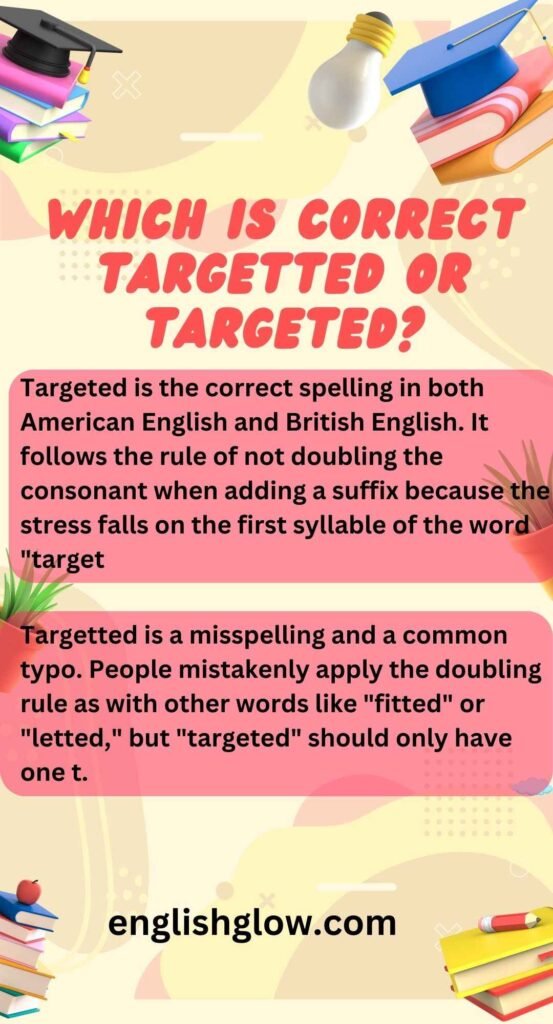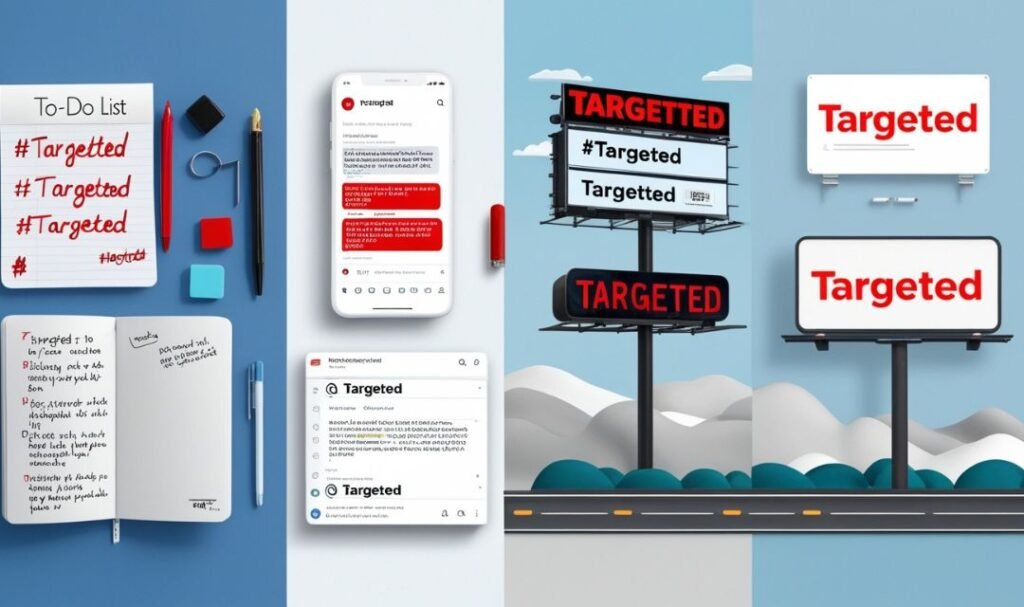When it comes to English, even seasoned writers sometimes pause to double-check certain spelling nuances. This is especially true for words that follow irregular rules or have variations in their usage. One prime example of this confusion is the word “targeted.” Many individuals find themselves questioning whether the correct spelling is “targeted” or “targetted,” making this a common area of confusion. It’s reasonable to pause, as English can be a tricky language full of exceptions and borrowed terms that don’t always follow predictable patterns.
For those wondering about the correct spelling, it’s essential to recognize that “targeted” is the accurate form, while “targetted” is a frequent misspelling. This occurs because of the consonant doubling rule, which can sometimes be confusing. In English, when a one-syllable word ends with a single consonant preceded by a single vowel, the consonant is typically doubled when adding a suffix (e.g., “run” becomes “running”). However, in the case of “target,” the stress is on the initial syllable, meaning the correct form is “targeted” without the extra “t.” Grasping these principles is essential to ensure proper usage in your writing.
Practical examples can help solidify this understanding. For instance, in marketing, a company might launch a targeted advertising campaign to reach young adults. In this context, “targeted” is accurately employed to signify that the campaign is directed at a specific demographic. Similarly, in a military setting, you may encounter the phrase “operation targeted enemy positions,” with “targeted” correctly indicating locations selected for focus. By examining these examples and understanding the rules, you can eliminate ambiguity and write with increased confidence.
Which is Correct: Targetted or Targeted?
People often have questions about how certain words are correctly spelled, especially when it comes to verbs like “targeted.” Is it targetted or targeted? The answer lies in understanding the spelling rules for adding “-ed” to the base form of a verb. When we write verbs in the past tense or participle form, we don’t add an extra consonant unless the word follows specific rules. In the case of “targeted,” the -ed is added without doubling the “t,” because the stress falls on the first syllable of the word. This is important to remember for accurate and clear writing, as a simple mistake can change how your work is perceived.
Many people get confused between words like “targetted” and “targeted,” much like how others mix up “benefited” and “benefitted” or “focused” and “focussed.” The key is in understanding the rule: when a single consonant at the end of a word is preceded by a vowel, it is only doubled if the stress falls on the final syllable, which is not the case with “target.” So, according to both British spelling and American usage, “targeted” is the correct form. This also aligns with the standards set by Oxford Dictionaries and Wiktionary, where “targetted” is marked as a misspelling.
Main Differences Between Targetted and Targeted
- Targeted is the correct spelling in both American English and British English. It follows the rule of not doubling the consonant when adding a suffix because the stress falls on the first syllable of the word “target.”
- Targetted is a misspelling and a common typo. People mistakenly apply the doubling rule as with other words like “fitted” or “letted,” but “targeted” should only have one t.
- Accurate spelling is important for maintaining clarity and professionalism in formal writing. In digital content, using the correct form is reinforced by spell-checkers and grammar-checkers.
- The correct spelling, targeted, is the standard form in dictionaries and linguistic references. It follows phonology and phonetics rules, making it easy to understand and accepted by language experts.
- Using the correct spelling improves communication, reflects education, and avoids confusion in online searches. It also aligns with the general consensus of language authorities, ensuring your writing meets professional standards.
You might enjoy reading:Vagrant vs Hobo: Key Differences You Need to Know
Understanding the Spelling: “Targetted” or “Targeted”? Examples and Clarification
- The correct spelling is “targeted,” not “targetted.” This is a common mistake, but understanding the rules of English can clear up any questions. When adding “-ed” to the base form of a verb like “target,” there is usually no doubling of the consonant because the stress is on the first syllable, making “targeted” the widely accepted and preferred
- Mistakes happen when people think there should be a doubling of the “t” in targetted, but this is wrong. In standard English, the rule states that consonants are only doubled when the preceding vowel is unstressed. Therefore, “targeted” follows the proper standard and doesn’t need the extra “t.” This rule applies to many situations, like a marketing campaign that is “targeted” toward a specific demographic or a police investigation focusing on a notorious
- To avoid confusion, remember that “targeted” is the correct form in all forms of writing, whether you’re discussing a teacher helping students in specific areas of improvement or crafting sentences for an effective marketing The language may have its variations, but “targeted” is the standard form in both past tense and past participle.
Examples of Targeted Usage
- Targeted therapy refers to medications and treatments designed to attack specific molecules or genetic mutations in a disease or condition. This approach helps patients by addressing the root cause more effectively.
- In targeted advertising, advertisements are directed at certain individuals or groups based on their demographics, interests, and online behavior. This makes the ads more relevant and increases the chances of engagement.
- Targeted marketing campaigns focus on specific segments of the population. These marketing strategies involve sending personalized messages that align with the preferences and behaviors of the chosen audience.
- In targeted recruitment, companies look for individuals with particular skills and qualifications that match the requirements of a job opening. This approach helps find the best candidate more efficiently.
- Targeted content recommendations use algorithms to suggest articles, videos, and products based on a user’s browsing history and preferences, enhancing the user experience.
- Targeted social media campaigns on various social media platforms focus on delivering content to a specific audience or demographic, making the campaign more relevant to the people it aims to reach.
- Targeted fundraising efforts aim at particular groups or individuals who are more likely to support a cause or organization, maximizing the impact of the fundraising initiatives.
- Targeted security measures involve implementing security protocols to address specific vulnerabilities and risks within an organization or system, ensuring stronger protection.
- Targeted customer service offers personalized support to meet the unique needs and resolve the specific issues of each customer, making assistance more effective.
- In targeted political campaigns, data analysis and voter profiling are used to tailor political messages and campaign strategies for different demographics and regions, improving the chances of success.
- Targeted healthcare interventions focus on providing specific healthcare interventions or programs to a defined population or patient group in order to address their unique medical needs.
- Targeted product development creates products that are designed for a specific target market, ensuring that the product meets the demands and expectations of that audience.
- Targeted environmental conservation efforts focus on protecting specific habitats, species, or ecosystems through conservation initiatives, ensuring more effective environmental protection.
- Targeted financial planning involves creating financial plans and investment strategies that align with an individual’s specific goals, risk tolerance, and overall financial situation.
Spelling Debate: “Targetted” vs “Targeted” with Examples
The question of whether it’s “targeted” or “targetted” is a common issue, especially for students and writers. Many people wonder how this word should be spelled when forming the past tense or participle. The base form of the verb is “target,” and when we add the -ed suffix, there’s no need for an extra “t”. The correct spelling is “targeted,” while “targetted” is simply wrong. To show this clearly, let’s look at a marketing campaign example. A company might create targeted advertisements that are focused on a specific audience, aiming to attract potential customers. The action of targeting refers to directing these ads toward a particular group of buyers. It’s important to remember the rule: if the stress is on the first syllable, as in “target,” there’s no need to double the consonant. Many people become confused, but keeping this rule in mind helps you make sure your writing is both clear and professional.
Point:
When it comes to spelling, many people get confused about whether it’s “targetted” or “targeted.” The correct form is “targeted” with only one “t,” but some folks mistakenly add an extra “t” because it sounds right. In English, using the correct spelling is super important for clear and accurate communication. If you don’t spell it right, you can create a mess that leads to misunderstandings. In professional settings, like in classes or proofreading, it’s crucial to avoid these mix-ups to keep your writing polished.
Decoding the Correct Spelling: “Targetted” or “Targeted”? Examples and Insights
Many people get confused when trying to spell “targetted” or “targeted.” The correct spelling is “targeted” with only one t, but some folks mistakenly add an extra “t” because it sounds right. In English, having the correct spelling is super important for clear and accurate communication, especially in professional settings like proofreading or classes. To avoid any mix-ups or misunderstandings, it’s essential to remember the right form and keep your writing clean and polished.
20 points about using Targetted and Targeted
- “Targeted” is the standard spelling used in both American English and British English.
- “Targetted” is a variant spelling but is considered a misspelling in modern usage.
- The word “targeted” is the correct form for the past tense of the verb “target.”
- The primary meaning of “targeted” is to aim or focus on a specific goal or objective.
- In both American and international English, “targeted” is the preferred and widely accepted form.
- Consistency in using “targeted” in formal documents is essential for clear communication.
- Spell check tools will flag “targetted” as a misspelling in most cases.
- If you’re unsure of the spelling, always consult a trusted dictionary to ensure accuracy.
- Both “targetted” and “targeted” are pronounced the same way, but the number of letters makes the difference.
- Targeted marketing refers to tailored strategies that focus on specific demographics or segments.
- In advertising, targeted ads are directed toward people based on their interests and behaviors.
- The use of “targeted” is common in business campaigns to ensure effective engagement with an intended audience.
- In academic writing, precision and consistent use of “targeted” add to the credibility of your work.
- Military operations often use the term “targeted strikes” to refer to directed actions against specific threats.
- In healthcare, targeted interventions are used to focus treatment on specific patient groups.
- In older texts, “targetted” may appear as an archaic spelling, but it is not favored in modern writing.
- Purists in writing and language prefer “targeted” to maintain professionalism and attention to detail.
- Proofreading is crucial to ensure the correct use of “targeted” for clarity and precision in your message.
- Using “targeted” shows a strong understanding of specificity required in business, military, and healthcare contexts.
- Consistently using “targeted” helps maintain professionalism and clarity in your written and verbal communication.
You might enjoy reading: Thank You Both vs Thanks to Both of You: What is main difference
Understanding the Spelling Variations: “Targetted” versus “Targeted” Explored
The spelling difference between “targetted” and “targeted” often causes confusion, but the correct form in both American English and British English is “targeted.” This is the standard spelling for the past tense and past participle forms of the verb “target,” meaning to aim or focus on a specific goal or objective. Using the correct spelling is important for clear communication, especially when following a style guide or writing for a professional audience. In modern usage, “targeted” is the widely recognized and accepted form, while “targetted” is an outdated variant that may seem archaic in today’s writing. For consistency in documents, always rely on spell check tools or consult a trusted dictionary if you are unsure. Both spellings are pronounced the same way, but “targeted” has only one “t” and fits with modern language rules, which is favored by purists for its clarity and precision.
Example
In a business context, targeted marketing strategies are commonly used to reach specific demographics. A company might develop tailored ads that are directed toward particular segments of their audience based on their interests and behaviors. This ensures that the message is effectively communicated to the intended audience, increasing engagement and improving the success of their campaigns.
Comparing Spellings: “Targetted” versus “Targeted” with Real-Life Examples
When we talk about communication, whether in business, school, or our everyday lives, getting the spelling right is essential. Many people ask about the difference between “targetted” and “targeted,” wondering which one is correct and why. Let’s dive into this and make things clear with some examples.
The Correct Spelling: “Targeted” – Why It’s Important
In my classes, one of the most important lessons is learning how to spell words correctly. When we write professionally, especially in marketing or business, using the right spelling can make a big impact. The correct spelling is “targeted”, and you don’t need the extra “t” in the middle.
- In marketing, a targeted ad campaign is used to reach a specific group of people. This means customizing your message to make sure it hits the right audience.
- Law enforcement or investigators often talk about using targeted surveillance techniques to focus on certain individuals or groups during investigations. Here, again, “targeted” is spelled without the extra “t”.
Common Mistake: “Targetted” – Why You Should Avoid It
Although many people might write “targetted”, adding that extra “t” is a mistake. When you want to make your writing clear and precise, remember that “targeted” follows the normal spelling rules of English.
- For example, if a company wants to create a targeted campaign, they need to be careful not to write it with the extra “t”. Incorrect spelling might affect how professional the message looks.
- Remembering the spelling is simple: just focus on the root word, “target,” and avoid doubling the “t”.
Real-Life Applications of “Targeted” Spelling
Here’s a helpful way to think about it: anytime you’re making a message that is meant to reach a specific group, whether in advertising or even in school assignments, use “targeted” to show that you are on point with your writing.
- In business, using the correct spelling reflects professionalism and attention to detail, which is crucial for successful communication.
- Even in everyday situations, like writing an email, spelling things correctly gives a sense of credibility.
Personal Tip: How to Avoid the “Extra T”
One trick I always show my students is to think of the letter “g” in “targeted” as a guide. There’s no need for an extra “t” because the “g” helps mean the word is already complete.
Conclusion
The appropriate use of spelling plays a crucial role in ensuring clarity and professionalism in your writing. Although some individuals may prefer the variant “targetted,” the correct and widely accepted form is “targeted.” It is essential to adhere to the conventional rules of the English language to avoid miscommunication and foster a consistent, comprehensible message for a wide audience. This article has explored the difference, offering explanations and examples to illustrate the commonly accepted use of “targeted.” By reviewing the rules of consonant doubling and analyzing practical examples, it is evident that using the correct spelling aligns with established patterns and helps prevent confusion.
Using the correct spelling is vital for maintaining clarity and precision in professional and academic environments. Whether you’re composing an essay, a document, or even a personal blog entry, paying close attention to detail reflects a dedication to high standards. A solid understanding of linguistic choices and their correct application bolsters the credibility of the writer. This commitment to standard practices minimizes the risk of misunderstandings and demonstrates a serious, well-crafted approach to communication.
For students, understanding the common pitfalls of spelling like this can save time and effort, avoiding second-guessing while improving overall confidence in expressing ideas. In educational settings, teachers and mentors can assist by offering guidance on these finer points, helping students develop their skills more efficiently. The ability to write clearly without worrying about errors not only enhances the writing experience but also improves the overall effectiveness of communication.
Frequently Asked Questions About “Targetted” and “Targeted”
1. Is “Targetted” a Correct Variant of the Word “Targeted”?
No, “targeted” is not considered a correct variant of the word “targeted.” The standard spelling in both American English and British English is “targeted” with a single “t.”
2. Are There Differences Between American English and British English in the Spelling of “Targetted” and “Targeted”?
In American English, the correct and standard spelling is “targeted,” and this is the preferred form in formal writing and technical documents. Some might think that “Targetted” is a British English variant, but this is incorrect. Even in British English, “targeted” is the preferred and acceptable spelling.
3. Can You Provide an Example Sentence Using “Targeted”?
Sure! Here’s an example:
“The company launched a targeted marketing campaign aimed at young adults.”
4. Why Should I Use “Targeted” Instead of “Targetted” in Documents?
It is advisable to use the standard form “targeted” in documents to ensure clarity and professionalism. Using the incorrect variant could confuse readers or be seen as an error, especially in academic papers or technical materials. It’s best to follow the common conventions of the English language.
5. How Do I Determine Which Spelling to Use in Different Contexts?
When writing in any context, especially formal or technical documents, it’s always best to opt for “targeted” as the correct spelling. This applies whether you’re working on a campaign, creating marketing materials, or drafting academic papers. There are no accepted variants of “targeted,” so always stick to the standard form.
6. Is “Targetted” Ever Acceptable in Any Context?
In professional and academic writing, it is not advisable to use “targetted”. Always use the standard spelling, “targeted,” to ensure your writing adheres to established conventions in the English language.
You might enjoy reading: Maximal vs Maximum: Discover the Crucial Difference





